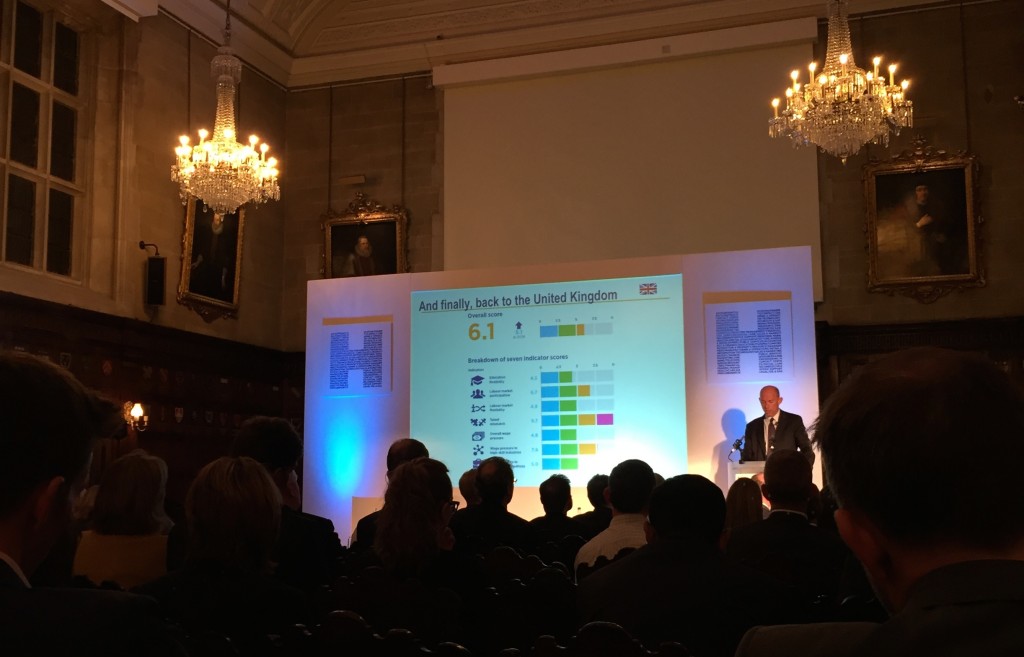Last week I attended an insightful event on behalf of the Global Engagement Hub at Bournemouth University – the launch of the 2015 Global Skills Index compiled by Hays – a leading global recruitment group. Hays has recently argued that there is a growing pressure in the skilled labour market as the global economy recovers from the economic downturn of the last few years and companies struggle to get the talent they need.
The event welcomed three prominent speakers: Alistair Cox (CEO, Hays PLC); Neil Carberry (Director for Employment & Skills, CBI); and Philip Thomas (Lead Economist, Oxford Economics), who discussed the highlights of the 2015 Global Skills Index. The speakers sought to provide their perspectives on the global talent landscape across a sample of 31 countries, with a particular focus on the current trends and challenges facing the UK talent landscape.
The talent landscape in the UK
So, how is the UK performing against the other 30 countries included in the Hays 2015 Global Skills Index (HGSI)? The straightforward answer would be, “not particularly well!” The UK’s overall 2015 score (i.e. 6.1 HGSI) on the Index has increased, when compared with 2014 figures (i.e. 5.1 HGSI); a higher HGSI score means that the UK is experiencing more pressure to align the skills and competences of its workforce in order to meet industry demands.
A breakdown of the overall picture for the UK also provides a somewhat worrying insight. This is particularly evident in the case of ‘talent mismatch’ – one of the seven key indicators used by Hays. The Index and its talent mismatch indicator in particular, suggest that the UK is experiencing a high level of talent mismatch across the 31 global economies included in the study, with a score of 9.7 out of 10. This may pose long-term, wide-reaching implications for the UK’s workforce and economy.
The long-term implications of talent mismatch to the UK
The high talent mismatch essentially means high unemployment, alongside a high rate of job vacancies. Talent mismatch has a direct impact over labour productivity and, in the long–run, over UK Plc.
Talent mismatch, as Alistair Cox (CEO, Hays PLC) pointed out on the evening, is when highly skilled jobs are being created and then go unfilled due to difficulties in finding the right kind of talent. Mr Cox also debated the wider, long-term implications of a skills mismatch, such as lowering economic growth:
“We see a pervasive shortage of skills in the UK. Skills shortages have now started to impact economic growth.”
Addressing high levels of talent mismatch is therefore an imperative for the UK economy and its status on the global index relative to competitor economies . Australia, for instance; one of UK’s key global talent competitors was seen to be among the high flyers of the 2015 Global Skills Index, mainly due to its considerably more flexible labour market and labour market policy. Our comparative infographic (below) provides more insights into the talent mismatch and how the UK is positioned in relation to other global economies.
All three speakers remarked that rethinking current policy and practice to help attract top foreign talent must be at the forefront of the government’s agenda if the UK is to stay competitive.
Whose responsibility? The role of universities in shaping talent
Neil Carberry, Director for Employment & Skills, CBI, highlighted the prominent role universities and university-industry partnerships have to play in preparing the talent to match the world of work and, as such, address the high level of talent mismatch in the UK.
@GlobalBU in response is shaping a #GlobalTalent Programme in order to bridge the education to employment gap that plagues HE and in so doing sets out to develop our students as the future talent workforce for our regions and for the globe.
Dean Hristov, Global Engagement Hub


